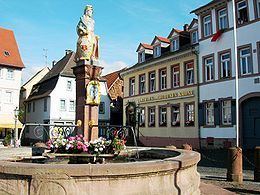Elevation 170-224 m (−565 ft) Population 21,324 (30 Jun 2009) | Time zone CET/CEST (UTC+1/+2) Local time Saturday 12:31 AM | |
 | ||
Weather 2°C, Wind SE at 8 km/h, 84% Humidity Points of interest Gruberhof, Rodensteiner Schloss, Darmstädter Schloss | ||
Groß-Umstadt is a town in the district of Darmstadt-Dieburg in the Bundesland (federal state) of Hesse in Germany. It is near Darmstadt and Frankfurt on the northern border of the Odenwald and is on the sout-eastern edge of the Frankfurt Rhein-Main Region. The highest point of the town is the Heidelberg (365 m).
Contents
- Map of Gross Umstadt Germany
- History
- Early mediaeval period
- Late mediaeval period
- Early modern period
- 19th and 20th centuries
- Gro Umstadt excluding the 8 other districts
- After their inclusion
- Mayors
- Culture
- Infrastructure
- Partner cities
- Sons and daughters of the town
- References
Map of Gross-Umstadt, Germany
The population is about 21,000 residents. About half of these live in Umstadt itself and the remainder in eight other districts which were combined with Umstadt in the state of Hesse government reforms in the 1970s:
The last of these includes Frau-Nauses.
History
Traces of palaeolithic habitation have been identified outside the town.
The settlement of Civitas Auderiensium was founded at Dieburg in AD 125 in the context of the Roman occupation of the section of the province of Germania Superior on the right bank of the Rhine. The foundation was followed by an orderly settlement and Romanisation of the district, and a market for agricultural produce was established. The main building of a "villa rustica" has been excavated under the current town church. This villa remained until the collapse of the Alemanni around AD 300. The town's history over the following 450 years until the first documentary evidence of the town is unclear. Alemannic and later Frankish tombs point to a settlement in the area of the town. The siting of the church in the core area of the former villa indicates an uninterrupted settlement, or at least to awareness of the previous settlement.
Early mediaeval period
After the conquest of Alemannic territory by the Franks, they established royal fortifications in order to secure control of the area. One such was undoubtedly established in Umstadt, the center of government of the Umstaedter Mark, which included the current municipalities of Otzberg, Höchst, Breuberg and Schafheim as well as Umstadt itself. At that time Umstadt had the status of a market town as well as a church and the seat of a Count. The first documentary evidence of the district was in 743 under the name of "Autmundisstat", which signified "Autmund's town" (possibly Edmund's). Another possible origin of the name is "ad montes" (near the mountains). In 766 the Fulda monastery acquired the ownership of the Umstaedter Mark, and by 985 it owned three churches, mills and vineyards here.
Late mediaeval period
By 1263 or earlier, Umstadt had obtained the status of a town as well as a town wall.
Konrad IV of Hanau incurred substantial debts in connection with his election as Prince Abbot of Fulda in 1373. He attempted to recoup these debts from the imperial abbey of Fulda after he came to power. Thus in 1374 he mortgaged the castle of Otzberg, the town of Hering and parts of Umstadt to his nephew Ulrich IV for 23,875 florins. Other parts were taken over by the Kurpfalz (the domain of the Electors Palatine), resulting in a condominium. There is physical evidence for this in two castles: the Hanauer Schloss which originated from the first moated castle at the town's NE corner, and the Pfälzer Schloss at the opposite corner. Between these were the mansions of the burghers of the town, including the seat of the Wambolts of Umstadt, which soon eclipsed the castles of both lords of the town.
Early modern period
In 1504 the town was conquered by Landgrave Wilhelm II of Hesse, who occupied it until the ownership of the town was clarified by the Diet of Worms in 1521. This resulted in another condominium, this time between Hesse and the Palatinate. As compensation Hanau received 12,000 guilders and several nearby villages, viz. Harperthausen, Kleestadt, Langstadt and Schlierbach.
Under this common ownership the town developed until shortly before the Thirty Years' War; the still extant town hall was built from 1596.
During the war the town was protected by its strong fortifications, preventing major destruction, but nevertheless there was great suffering, not least during the plague in 1634-36.
The town was briefly occupied and laid waste by a force of 600 dragoons under Marquis of Barbistere in December 1688 during the war of the Palatine succession.
19th and 20th centuries
In 1802 the Landgraviate of Hesse-Darmstadt took over the joint dominion of the town, which was the 2nd most important town of the district of Dieburg which was founded at that time. From 1857 the town adopted the name of Gross-Umstadt to distinguish it from Klein-Umstadt and Wenigumstadt. Many factories were established in the town after it obtained a railway connection.
In the election of 1933, 60% of the inhabitants voted for the Nazis, and in 1938 the town's synagogue was desecrated. After WW2 the town's population grew to about 22,500 following several expansions to its boundaries. There is now a substantial Portuguese community.
Groß-Umstadt (excluding the 8 other districts)
After their inclusion
(December 31)
Mayors
Culture
Each year at the weekend after September, 15th there is the "Winzerfest" (a wine festival) which attracts tens of thousands of people.
Infrastructure
Gross-Umstadt has schools for students of all ages and a general hospital.
